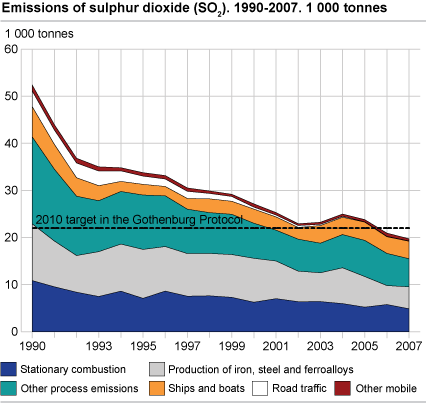Content
Published:
Historically low sulphur dioxide emissions
Norwegian sulphur dioxide emissions were reduced by 6 per cent from 2006 to 2007, resulting in the lowest emission figures in modern time. The decrease was mainly due to reduced emissions from stationary combustion, but emissions from industrial processes were also reduced.
This appears from preliminary calculations performed by Statistics Norway in close cooperation with the Norwegian Pollution Control Authority.
The Gothenburg Protocol is an international environmental agreement that intends to limit emissions of long-range transboundary emissions to air, i.e. emissions transported over long distances and which may have consequences for other nations. The agreement has been ratified by most European nations and the USA. Under this agreement Norway has committed itself to emit no more than 22 000 tonnes sulphur dioxide (SO2) in 2010. In 2006, the emissions were below this level for the first time and in 2007 the emissions totalled 19 700 tonnes, according to preliminary calculations.
|
Sulphur dioxide (SO2) is a gas that is created when sulphurous materials, particularly oil and coal, are combusted, as well as in a number of industrial processes. It has an acidifying effect on earth and water and may cause material damage. SO2 may also cause respiratory disorders. However, the concentrations in outdoor air in Norway are currently too low to represent any health risk. It is assumed that approximately 90 per cent of sulphur downfall in Norway originates from other countries, particularly Great Britain, Germany and Poland. This has caused strong acidification of many lakes in the southern part of Norway, with major consequences for many fish stocks. The emissions are decreasing in the countries which contribute most to the downfall in Norway, and they too will most likely fulfil their emission obligations. |
Large emission reduction
During the last decades there has been a marked decrease in Norwegian SO2 emissions. In 2007, the emissions were 86 and 62 per cent lower than in 1980 and 1990, respectively. The emissions were reduced by 6 per cent from 2006 to 2007.
Since 1990, emissions from industrial processes have been reduced by 65 per cent. The corresponding figures for stationary and mobile combustion are 55 and 61 per cent, respectively. The decrease in combustion emissions may be attributed to lower sulphur content in oil products and, for stationary combustion, less use of oil. The industrial process emissions have been reduced since 1990 due to new cleansing measures, less sulphur in reducing agents and the closing down of some plants.
Three quarters of the emission reduction from 2006 to 2007 is due to lower emissions from stationary combustion. The use of heating oil was lower in 2007 than in the preceding year, and lower sulphur content in the oil sold also contributed to the reduction. Emissions from industrial processes also went down, but the reduction was partly offset by increased emissions from metal production, i.a. because one metal producer who was inoperative in 2006 started up again in 2007.
Manufacturing industry most important emission source
Process and heating emissions from the manufacturing industry accounted for almost three quarters of the SO2 emissions in Norway in 2007. More than half of the total emissions came from industrial processes, particularly metal production. The production of iron, steel and ferroalloys accounted for one quarter of the total Norwegian SO2 emissions. Stationary combustion outside the manufacturing industry and mobile combustion accounted for 6 and 21 per cent of the emissions respectively.
Second to the manufacturing industry, shipping is the largest contributor to Norwegian SO2 emissions. Domestic shipping and fishing accounted for 19 per cent of the emissions in 2007. Less than 3 per cent of the national SO2 emissions in 2007 came from air traffic, road traffic and motorised equipment.
Oil and gas activities, which are a major emission source for CO2, are insignificant with regard to emissions of SO2, i.a. because natural gas contains very little sulphur.
Emissions from international air and sea transport are not covered by the Gothenburg Protocol, neither are they included in the national emission figures.
Uncertainty
There is some uncertainty connected to these preliminary calculations. Among other things the distribution of use of heavy oil between on-shore activities and use in ships is uncertain. For ships, an uncertainty in the distribution of heavy fuel oil between domestic and international sea transport in the sales statistics for petroleum products, results in uncertainty in the emission figures.
Sulphur dioxide emission figures distributed by source for the years 1990, 2005 and 2006 were published in February 2008 . Corresponding figures for 2007 will be published in February 2009.
Read more about acid rain on http://www.miljostatus.no/
Tables:
The statistics is published with Emissions to air.
Contact
-
Statistics Norway's Information Centre
E-mail: informasjon@ssb.no
tel.: (+47) 21 09 46 42

